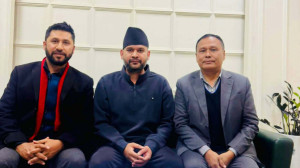Politics
Poll prospects of new parties depend on how alliances evolve
Formation of CPN (Unified Socialist) and Loktantrik Samajbadi could lead to vote splitting, and for them to gain, they will have to rely on others.
Tika R Pradhan
If Nepali political parties see no more splits, there will most likely be six major ones contesting the elections, local in seven months and parliamentary next year, apart from some fringe forces.
With the splits in the CPN-UML and the Janata Samajbadi Party, two new parties–CPN (Unified Socialist) and Loktantrik Samajbadi Party–are also represented in Parliament.
The UML with 98 seats is currently the largest party, followed by the Nepali Congress with 61 seats and the Communist Party of Nepal (Maoist Centre) with 49 seats. The Janata Samajbadi has 19 seats. The CPN (Unified Socialist) has 23 seats while the Loktantrik Samajbadi Party has 13.
The Election Commission has given until September 7 to those who were earlier elected at the provincial and local levels under the UML and Janata Samajbadi Party to choose their sides. It, however, has not said anything about those elected to the House of Representatives under the UML and Janata Samajbadi.
With elections just around the corner, the parties’ focus is now on strengthening their voter bases. For the new parties, the local elections will be crucial as they will define how the parties will fare in the general elections.
Observers say poll prospects of Madhav Nepal’s newly registered CPN (Unified Socialist) and Mahantha Thakur’s Loktantrik Samajbadi Party do not look very encouraging at this point of time. They, however, could create some obstacles for the parties that they split from, according to them.
According to Jhalak Subedi, who follows Nepal’s left politics closely, Nepal’s party could get around 12 percent of the UML’s vote share.
“The CPN (Unified Socialist) might steal around 20 percent of leaders and cadres from the UML,” he said.
In 2017, the UML and the Maoist Centre had forged an electoral alliance. Of the 165 constituencies up for grabs under the first-past-the-post system, UML had won in 80 and the Maoist Centre in 36. Under the proportional representation system, the UML had won 41 seats while the Maoist Centre had won 17 seats.
The Nepali Congress had won 23 seats under the direct election system and 40 seats under proportional representation.
The vote shares of the UML and the Congress, however, were almost equal under the proportional representation system while in the direct election system, Congress had a slightly better vote share than the UML’s.
With the CPN (Unified Socialist) likely to steal votes from the UML, Congress looks set to benefit. The split in the UML, however, will give some breathing space for the Maoist Centre as well, observers say.
The Maoist Centre’s vote shares under the proportional representation and first-past-the-post systems in the last elections were 13.66 percent and 15.04 percent, respectively.
At the time of registration of the CPN (Unified Socialist), it had 55 of the 203 Central Committee members from the UML.
With the split in Kathmandu creating deep divisions in the biggest communist party up to the grassroots level, the UML is likely to suffer, observers say. Nepal has already formed parallel committees in most of the districts.
According to Subedi, Madhav Nepal is left with no option than to forge an electoral alliance, either with the Nepali Congress or the Maoist Centre, and the latter too will be positive about such an alliance.
For the Pushpa Kamal Dahal’s Maoist Centre, which was on the verge of losing its relevance, the split in the UML is a godsend.
If Nepal and Dahal can forge an alliance, they could give the UML a run for its money.
UML chair KP Sharma Oli, however, appears to be unperturbed. He has yet to admit that his UML party has split.
While addressing a function organised by his party on Saturday, Oli made light of those who had parted ways.
“They [the Nepal faction] cannot compete against the UML,” said Oli. “It’s also clear from their statements that they would forge an alliance with other forces during elections.”
The current alliance of the Congress, Maoist Centre, CPN (Unified Socialist) and Janata Samajbadi may work well for running the government, but when it comes to poll alliances, the Congress party may not align with communist forces. With the party having a significant voter base in the Tarai also, it may not seek support from the Janata Samajbadi Party or Loktantrik Samajbadi Party.
On top of that, the Congress itself has too many aspirants, and convincing them to forgo their seats for others will be an uphill task. With the UML not having a good organisational base in the Tarai, the split in the Madhes-based parties is also likely to help the Congress.
Observers say the split in the Janata Samajbadi may not hamper Upendra Yadav much and that Thakur could be on the receiving end.
The Janata Samjabadi was formed in April last year after a merger between the Samajbadi Party, which itself was born out of a unity between Sanghiya Samajbadi Forum and Naya Shakti, and the Rastriya Janata Party, Nepal.
Baburam Bhattarai was the sole winner to the lower house in 2017 elections under the direct election system. His party did not win a single seat under the PR system.
The Rastriya Janata Party itself was a medley of at least six different Madhes-based parties that had decided to come under one umbrella on the eve of the 2017 local polls.
During the last polls, Sanghiya Samajbadi Forum of Upendra Yadav had 4.95 percent vote share under the proportional representation system and the Rastriya Janata Party had 4.93 percent.
Upendra and Thakur had formed an alliance in the 2017 elections, thereby managing to keep the Congress, the Maoist Centre and the UML at bay. Province 2 was the only province where the communists could not form the government.
“You never know… they can form an alliance again when polls are near,” said Chandrakishore, a journalist who closely follows Madhes politics. “They might realise sooner or later that they would be stealing each other’s votes.”
At this point, he says, it is difficult to make any predictions.
With tensions simmering in the Janata Samajbadi Party also, things could change faster than expected.
“Much will depend also on how the national political alliance evolves,” said Chandrakishore.
Even though Madhav Nepal has formed his own party, out of compulsion, as Oli had pushed him too far, rather than choice, he has not ruled out an alliance with the UML, if need be.
Despite bitterness grown to an optimum level, when it comes to polls, Nepal and Oli could mend fences as well, observers say. After all, both had been in the same party for over four decades. It was just a little over three years ago, Oli, who would not see Dahal eye to eye, had agreed not only to an electoral alliance but also a merger.
Political analyst Hari Roka says since Madhav Nepal has created parallel structures in most of the districts, he might not fare badly.
“Oli does not seem to have any agenda. And if Nepal goes to polls under alliances with the Maoist Centre and Janata Samjbadi, the CPN (Unified Socialist) has a fighting chance to make its presence.”
If the voting pattern of the Nepali voters is anything to go by, major parties’ vote shares, by and large, remain the same.
During the second Constituent Assembly polls in 2013, the Nepali Congress’ vote share under the proportional representation system was 25.55 percent, while the UML had 23.66 percent. The Maoist party, which had emerged as the single largest party in 2008 elections, was relegated to the third party. Its vote share was 15.21 percent.
The Congress emerged as the single largest party in the 2013 polls.
Party splits in general not only reduce the chances of winning but also contribute to a substantial loss of seats, according to experts who have overseen elections.
“There may be some die-hard followers who would vote for some individuals, like we saw in the case of Bamdev Gatuam, but such voters do no necessarily help the party win elections,” said Neil Kantha Uprety, who served as chief election commissioner from February 2013 to April 2015. “I don’t think alliances between parties of different ideologies really work for the voters.”
Gautam had split from the UML in 1997 to form the CPN-ML. But in the 1999 elections, his party could not win even one seat. Instead, the UML faced a loss.
The Congress managed to raise its number of seats from 83 in the 1994 elections to 111. The UML, which had won 88 seats in 1994, won 71. There, however, was not much difference in vote shares.
How Madhav Nepal’s party fares will be clear once elected representatives in provinces and local bodies under the UML take sides, according to Radha Krishna Mainali, a communist leader who was earlier with the UML but currently is not in active politics.
“The CPN (Unified Socialist)’s fate will be determined by how Nepal as party chair strengthens his committees at lower levels and how he strategises alliances with other parties, including the Janata Samajbadi,” said Mainali. “He can have some advantage of the strong base of the UML. It depends on how he does his politics.”




 9.12°C Kathmandu
9.12°C Kathmandu













%20(1).jpg&w=300&height=200)

